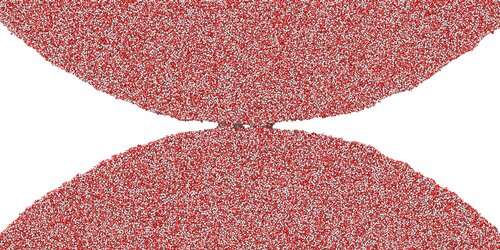Supercomputer sheds light on how droplets merge

Scientists have revealed the precise molecular mechanisms that cause drops of liquid to combine, in a discovery that could have a range of applications.
Insights into how droplets merge could help make 3-D printing technologies more accurate and may help improve the forecasting of thunderstorms and other weather events, the study suggests.
Simulated interactions
A team of researchers from the Universities of Edinburgh and Warwick ran molecular simulations on a supercomputer to analyse interactions between tiny ripples that form on the surface of droplets.
These ripples – known as thermal-capillary waves – are too small to be detected by the naked eye or by using the most advanced experimental techniques.
Researchers found that these tiny waves cross the gap between nearby droplets and make the first contact between them.
Once the droplets have touched, liquid molecules draw the two surfaces together like the zip on a jacket, the team says. This leads to the complete merger of the droplets.
Liquid behaviour
Studying the dynamics of merging droplets could help to improve understanding of the conditions that cause raindrops to form in developing storm clouds, the team says.
The team used the ARCHER UK National Supercomputing Service – operated by EPCC, the University's high-performance computing facility – to run their simulations.
These used thousands of processors to model interactions between nearly five million atoms.
The research, published in the journal Physical Review Letters, was supported by the Engineering and Physical Sciences Research Council.
"We now have a good understanding of how droplets combine at a molecular level. These insights, combined with existing knowledge, may enable us to better understand rain drop growth and development in thunderstorms, or improve the quality of printing technologies. The research could also aid in the design of next-generation liquid-cooling systems for new high-powered electronics," says Sreehari Perumanath, School of Engineering, University of Edinburgh.
"The theoretical framework developed for the waves on nanoscale droplets enabled us to understand Edinburgh's remarkable molecular simulation data. Critically, the new theory allows us to predict the behaviour of larger engineering-scale droplets, which are too big for even ARCHER to capture, and enable new experimental discoveries," says Dr. James Sprittles, Mathematics Institute, University of Warwick.
More information: Sreehari Perumanath et al. Droplet Coalescence is Initiated by Thermal Motion, Physical Review Letters (2019). DOI: 10.1103/PhysRevLett.122.104501
Journal information: Physical Review Letters
Provided by University of Edinburgh




















